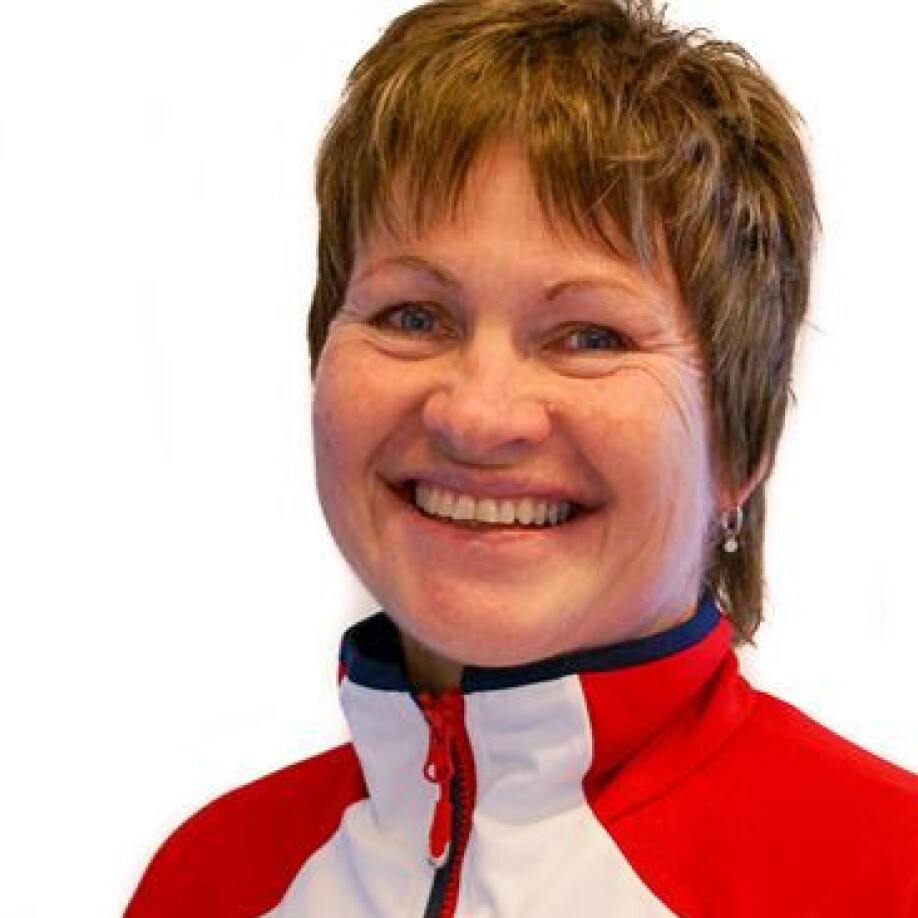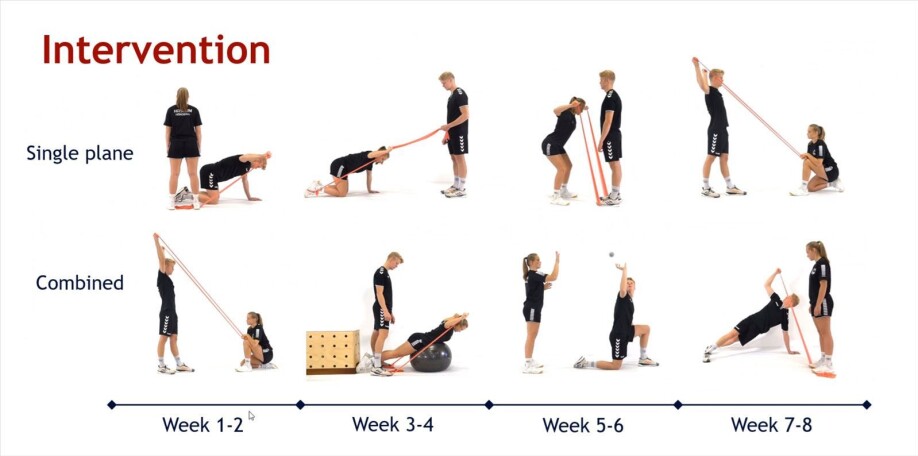THIS ARTICLE/PRESS RELEASE IS PAID FOR AND PRESENTED BY The Norwegian School of Sport Sciences - read more

More strength training should prevent shoulder injuries
A high number of handball players struggle with shoulder injuries, but what can we do to help them when they themselves feel that prevention takes too much time?
This story actually starts out with what we believed to be the answer to the question of how to simply reduce the number of shoulder injuries among handball players.
All that was needed was a simple, preventive programme carried out during warm-up. However:
In retrospect, it has emerged that neither the players nor the coaches were willing to carry out the programme, because they felt it took too much time. This may not be the smartest decision, but it is a fact – and something witnessed in several sports.
Hilde Fredriksen decided to find a solution to the problem. Her project has resulted in a doctoral thesis that she will defend in a public defence on 16 April.

Complex throws
The shoulder is the most mobile joint in our bodies, and the action of throwing is an extremely complex movement, performed at a high speed and representing a significant strain on the shoulder joint and surrounding muscles. If you are a thrower in a sport, your shoulder not only has to be very mobile, it also has to be stable and strong enough to keep your shoulder in position during the throw. This requires a delicate balance between mobility, stability and strength.
Handball players use many different types of throws, such as overarm throw, underarm throw, throw on the run and throw in suspension, but the fundamental kinematics in these throws are essentially the same:
- You first draw the arm back with a high degree of external rotation
- In the acceleration phase, you bring the arm quickly forwards at the same time as a powerful internal rotation until you release the ball. (This requires activity by strong muscles such as the pectoralis major and latissimus dorsi.)
- Braking the movement of the arm requires powerful activation of the external rotator muscles. These have to work eccentrically to brake the arm’s movement and at the same time stabilise the shoulder joint. (“Eccentrically”: The muscle develops power as it is extending.)
No increase in either mobility or strength
“Our aim was to keep things simple: We already had a preventive programme comprising five exercises that worked, but that were not used. We had to find a solution,” explains Hilde Fredriksen. The goal with the five exercises was, e.g., to improve mobility in the shoulder’s internal rotation and to increase the strength of the shoulder’s muscles for external rotation.
“Several studies show that these two factors are important in relation to the risk of shoulder injuries. We had to make the programme shorter – but we did not know which exercises were most effective and what we should keep.”
Hilde Fredriksen decided, therefore, to start a new study. Four handball clubs with boys and girls aged 16-18 from Oslo and the surrounding area were selected for participation. They all used the injury prevention programme, but this time they tested the extent to which the programme affected shoulder mobility and strength.
The results were surprising: Although the programme appeared to be preventive, it did not provide any increase in mobility or strength.
“The dose was probably too low. Or in other words: The players spent too little time on each exercise, and the weight they used for the strength exercises were too low to produce any effect,” claims Hilde Fredriksen. In her opinion, the fact that the programme seemed to prevent injuries is due to the fact that it is a good warm-up programme. “It was a good programme for preparing the shoulders for a handball training session. But we didn’t really get any further.”
Meticulous testing of exercises
Strength is an important factor, however. This had been proven in former studies in this area. They have demonstrated that programmes dedicated to weight training are more preventive than combined programmes with several elements.
Several studies also indicate that weak external rotation muscles are a risk factor. Hilde Fredriksen therefore decided to take this further:
She invited 16 experts from nine countries – physiotherapists, doctors, coaches, players and weight training experts – to a so-called Delphi consensus study to identify those exercises that were most effective in increasing strength in these muscles. The group assessed and graded a total of 28 exercises according to both effect and how probable they felt it was that the handball players would carry out the exercises.
“After three rounds of such assessments, we were left with eight exercises that we combined to create a short programme,” explains Hilde Fredriksen. We paired up sets of two exercises, with one pair to be completed for each training session. The players switched between these pairs of exercises every second week.
“The exercises to increase strength have to use sufficiently heavy weights. But when we allowed a handball club to test this programme during warm-up, we discovered a problem. Training with weights meant that the players were tired and were less precise in their throws,” explains Hilde Fredriksen. “We therefore learned that weight training during handball training should be carried out after training, and not as part of the warm-up.”
The programme was therefore issued to six new handball teams, to be carried out after handball training, three times a week for eight weeks. However, this programme also failed to produce any improvement in muscle strength.
“Once again, it is possible that the dose was too low. Although the exercises should have been heavy enough to have an effect on strength, one of the premises was that the programme had to be short, so that the players would complete it. Looking back, we realise that it would probably be best to carry out the programme as separate weight training sessions, with the main focus on increasing strength.”
The study was carried out during the first part of the season, from September to December. In retrospect, Hilde Fredriksen believes it would have been more appropriate to develop strength before the season starts and then maintain it during the season.
“If we can develop robust players who are well-prepared for the demands the sport makes on their bodies, they will be able to perform better and, most probably, have a reduced risk of injury.”

New tool, better follow-up
Preventing injuries is referred to as “primary prevention”. As handball players often have recurring and long-term shoulder injuries, it is also important to detect an injury at an early stage, so that positive action can be taken – so-called “secondary prevention”. This implies making sure that the player is entirely rehabilitated before he or she fully returns to the handball court.
The use of a report form filled in by the players helps document pain and other symptoms in the shoulder over time, in order to quickly detect changes. This form would also represent a good tool, together with clinical tests, during rehabilitation of players, helping monitor progress.
This type of form – “the KJOC form” (1) – has been available in English but not in Norwegian. One important part of Hilde Fredriksen’s study was therefore to translate and customise the form for Norwegian athletes. She also tested the form’s measurement properties:
“We have been lacking this type of important tool, but now we have something that works,” she claims. “It measures what we need and is a good tool for doctors and physiotherapists who work with athletes who are throwers, to provide better follow-up for such athletes than before.”
Hilde Fredriksen summarises as follows:
- A good warm-up programme prepares the players for the activities in the game. This also improves their performance.
- By developing a warm-up programme based on the requirements made by the sport and the injuries to which the players are exposed, injuries can also be prevented.
- By both developing robust players and ensuring good warm-up programmes, the players will most likely perform better and suffer fewer injuries. The coach will have more players without injuries on the team, and the team will perform better. This is a win-win situation.
References:
Hilde Fredriksen: Forebygging av skulderskader i håndball. Utfordringen med gjennomføring av forebyggende tiltak, Doctoral dissertation, Norwegian School of Sport Sciences, 2021. (Public defence on 16 April)
Hilde Fredriksen et.al.: Development of a Short and Effective Shoulder External Rotation Strength Program in Handball: A Delphi Study, Physical Therapy in Sport, 2020. (Summary)
———
Read the Norwegian version of this article at forskning.no
See more content from The Norwegian School of Sport Sciences:
-
Football expert wants to change how people watch football at home
-
Kristine suffered permanent brain damage at 22: "Life can still be good even if you don’t fully recover"
-
Para sports: "The sports community was my absolute saving grace"
-
Cancer survivor Monica trained for five months: The results are remarkable
-
What you should know about the syndrome affecting many young athletes
-
New findings on how athletes make the best decisions





































